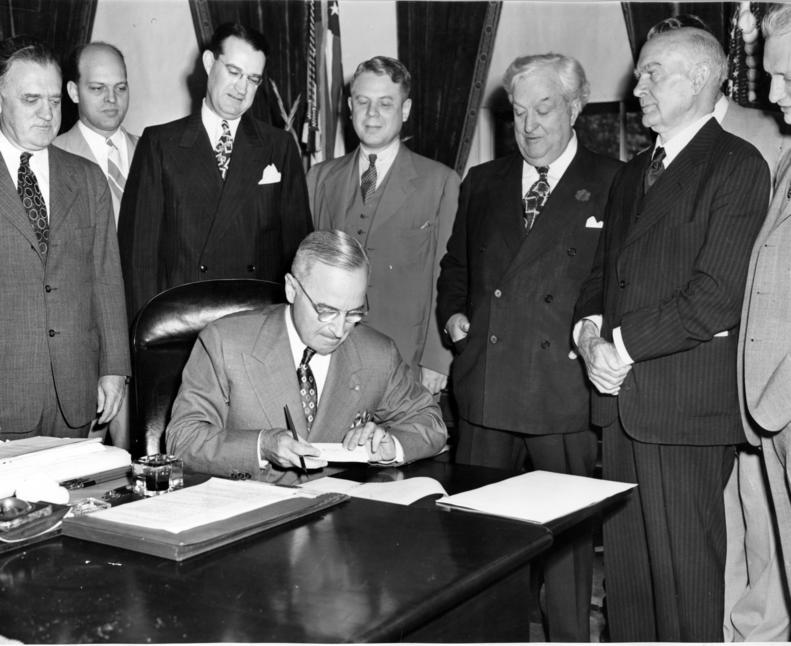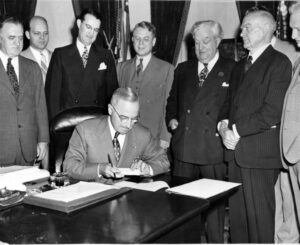
What is the Administrative Procedure Act?
By Madison Grosvenor
Who makes sure federal agencies play by the rules when their decisions impact Alaska’s land, water, and people?
“The law” is the short answer.

President Harry S. Truman signs the Administrative Procedure Act into law. Photo courtesy of Harry Truman Presidential Library.
The Administrative Procedure Act, enacted in 1946, governs how federal agencies create and implement regulations and provides sideboards for how agencies make all their decisions. It ensures that government actions are transparent, accountable, and open to public input. At its core, the Administrative Procedure Act balances the need for efficient administration with the public’s right to be heard and protected from arbitrary decisions.
This foundational law matters in profound ways because federal agencies make decisions that can shape the future of the environment and the rights of people.
The act requires agencies to provide clear explanations for proposed rules and gives individuals the opportunity to submit comments and feedback during the rulemaking process. This public participation helps shape policy and ensures diverse perspectives are considered. Additionally, the Administrative Procedure Act allows courts to review agency actions, offering a crucial check on agency decisions that may be unreasonable or unjustified.
Through these mechanisms, the act strengthens democratic participation and reinforces the rule of law in federal policymaking.
What’s required?
Trustees for Alaska looks to the Administrative Procedure Act when challenging state and federal agency decisions that threaten Alaska’s lands, wildlife, and people without following proper legal processes.
Whether it’s issuing permits for large-scale mining projects, weakening protections for protected wildlife, or opening public lands to harmful industrialization, Trustees relies on the act to ensure agencies provide public notice, provide opportunities for public comments, and justify their decision-making.
If an agency fails to follow proper procedure, there may be legal grounds to challenge that action in court. In fact, many of Trustees’ cases demonstrate how agencies violated the act by failing to justify their decisions, curtailing public comments, or skipping steps in the process.
The act also governs how agencies conduct formal hearings and adjudications, providing a framework for fairness when individuals or organizations are affected by agency actions.

Fall colors at Izembek Lagoon. Photo by Kristine Sowl, USFWS.
This is especially relevant in Alaska, where decisions about land use, resource extraction, and permitting often involve complex legal disputes. The act ensures that those impacted have the right to be heard.
One example of the act playing a big role in our cases is the decades-long legal battle over a proposed road through the Izembek National Wildlife Refuge.
For years, the Department of the Interior rejected efforts to advance the road due to overwhelming environmental concerns supported by scientific evidence. But in 2019, a sudden policy reversal by Secretary David Bernhardt approved a land exchange deal with little explanation. Trustees successfully challenged that reversal under the Administrative Procedure Act, arguing the agency failed to justify its abrupt change in decision or consider the existing factual record. These are classic violations of the act’s requirements.
While the legal fight around Izembek continued for years, the case shows how the act protects the public from arbitrary agency actions and unexplained policy flip-flops.
These legal standards provide an avenue for Trustees to help safeguard Alaska’s ecosystems and communities from arbitrary or politically driven actions that ignore environmental law and public interest.
How it works for regulations
An important aspect of the Administrative Procedure Act is its requirements about how agencies create regulations. The law requires agencies to publish a detailed notice in the Federal Register when starting a rulemaking process. The notice must explain what the proposed rule is, cite the legal authority behind it, and set a clear timeline for public comment.
This notice and comment provisions are designed to keep agencies transparent with their rulemaking and give the public a voice in that process.
Stakeholders (communities, people impacted, people with an interest, or in other words, you) are then invited to submit feedback on the proposed rule.
For organizations like Trustees for Alaska and our clients, this can be a critical moment. It’s our chance to weigh in with scientific evidence, legal arguments, and community voices to influence decisions that affect Alaska’s ecosystems and communities.
After the comment period, the act requires agencies to consider the public input they’ve received. This is designed so that organizations, individuals, and legal advocates like Trustees can have a direct role in shaping outcomes.
Totally arbitrary!
In the world of environmental law, few phrases carry as much weight— or as much punch— as “arbitrary and capricious.”
Under the Administrative Procedure Act, these words are the legal red flag that signals that something, somewhere, has gone wrong in the decision-making process.
If a federal agency issues a rule or permit without solid reasoning, ignores critical facts, or changes policy without explanation, a court can throw that decision out for being arbitrary and capricious.
An agency denying a permit without providing a clear explanation for the denial could be considered arbitrary and capricious. Similarly, if an agency changes its policy without considering the potential impacts on affected parties, or relies on flawed data to make a decision, its action may be challenged as arbitrary and capricious.
In simple terms, it means the agency acted irrationally or without enough thought, and the Administrative Procedure Act doesn’t let that slide.
The act in action
As mentioned earlier, the Izembek case stands out as a clear example of how the Administrative Procedure Act serves as a critical check on federal decision-making.
After Trustees for Alaska challenged the land swap under the Administrative Procedure Act and won in district court, Interior appealed.

Attorneys Jennifer Bennet and Bridget Psarianos minutes before Ninth Circuit argument. Photo by Dawnell Smith
In March 2022, a small panel of the Ninth Circuit Court issued a 2-1 decision allowing the land exchange. We promptly filed a petition for en banc review, urging the full Ninth Circuit Court to reconsider due to the dangerous legal and practical consequences of the ruling, including that it would allow an Interior secretary to reverse longstanding agency policy with minimal or no explanation, opening the door to commercialization of lands Congress had protected for future generations.
As a part of this en banc petition, a group of law professors submitted an amicus curiae brief in support of our petition for rehearing. Outlined in this brief were the numerous ways this land-swap proposal violated federal law, including the Administrative Procedure Act.
The briefing argued that the reversal claimed to “rebalance” environmental and socioeconomic values but did so “without engaging with the prior factual record” or explaining why earlier conclusions were no longer valid.
While an agency is allowed to change policy, they must offer more than a mere shift in preference; it must confront and justify its departure from past findings. Secretary Bernhardt’s memorandum failed to do this. He claimed he would have reached a different outcome “even assuming” the same facts, effectively using policy discretion as a shield against factual inconsistency.

Refuge sign of Izembek NWR. Ryan Hagerty, USFWS public domain.
In other words, this approach violated the Administrative Procedure Act in two key ways. First, it reversed prior policy without providing the necessary analysis or explanation. Second, it relied on the claim that the Izembek land swap—trading protected wilderness for a road—served the social and economic interests of all Alaska Native communities, which was not supported by the factual record.
We argued the case en banc in December of 2022.
In the spring of 2023, Secretary of the Interior Deb Haaland announced that the department would withdraw from the land exchange, and the court dismissed the case as moot.
This Izembek case shows why the Administrative Procedure Act matters: agencies can’t ignore facts or flip policies without an explanation. It’s a safeguard against arbitrary decisions, especially when the stakes are this high.
No flip-flopping
In another case, we sued Interior and the National Park Service in 2020 for violating the agency’s Organic Act, the Alaska National Interest Lands Conservation Act, and the Administrative Procedure Act, after the Park Service adopted a rule that would open up national preserves in Alaska to destructive hunting practices like baiting brown bears and killing wolves during denning season.
For years, the agency stood firmly against liberalized hunting practices intended to act as predator reduction practices, consistently stating that such methods (like killing bears with cubs or hunting wolves during denning season) were incompatible with its legal obligations under the Organic Act and ANILCA.

Brown bear walking in Katmai National Park and Preserve. Photo by F. Jimenez / National Park Service
The agency did a complete 180-degree turn without adequately explaining why in 2020. The Administrative Procedure Act doesn’t ban policy changes outright, but it does require agencies to own up to their reversals and offer clear, well-reasoned justifications. The Park Service didn’t do that. Instead, it pretended like the prior stance never existed and offered no real meaningful explanation for abandoning it.
Under established legal precedent, agencies can’t just change their minds because of a new administration or political pressure. When an agency contradicts its own prior findings, it must do more than just say, “We think this is better now.”
Agencies must explain why the old facts no longer apply or why it’s reasonable to disregard them, and the Park Service simply didn’t do that.
In court, Trustees argued that the flip-flop ignored years of clear, longstanding evidence that the Alaska Board of Game’s approved hunting methods were not consistent with federal mandates because they were aimed at wiping out predators to increase game populations and pretended bear baiting and shooting cubs in dens somehow fit within conservation mandates. It also dismissed documented predator declines, including those on preserve lands, and relied on unreliable harvest data that lacked preserve-specific information and real-time monitoring. On top of all this, it falsely claimed that the approach would sufficiently protect wildlife.
Altogether, it was a head-spinning decision that, under the Administrative Procedure Act, was arguably arbitrary and capricious.

Float plane above mother bear and cubs on Naknek Lake in Katmai National Park and Preserve. Photo by Paxson Woelber.
This kind of unjustified flip in policy is exactly what the Administrative Procedure Act was designed to prevent: arbitrary, inconsistent rulemaking that undermines public trust and legal accountability.
In 2022, the U.S. District Court ruled aspects of the 2020 rule were arbitrary and sent it back to the Park Service for revision but allowed it to remain in effect.
While an appeal was pending on the District Court’s ruling, the Park Service issued a new 2024 rule that banned bear baiting but, unlike its previous 2015 rule, acknowledged the authority to ban brutal hunting practices without explicitly prohibiting them.
Threats to accountable rulemaking
The Administrative Procedure Act is a bedrock law and is intended to be a safeguard to ensure transparent and accountable governance across all areas of federal decision-making.
It ensures that agencies explain their decisions, consider public input, and follow the law. Without it, agencies could act unilaterally, risking the environment, public health, and community rights without oversight.
However, bedrock administrative law is shifting, as well as how courts interpret it.
We have already seen National Environmental Policy Act regulations be rescinded, and other environmental regulations are under threat. President Trump even attempted to fast-track the repeal of energy and environmental regulations by calling for agencies to include automatic expiration (“sunset”) provisions and bypass the Administrative Procedure Act’s mandatory notice-and-comment process, which would violate the act’s procedural safeguards designed to ensure deliberate, transparent, and rational regulatory changes.

Bridget Psarianos, senior staff attorney with Trustees, in the courtroom before the Ninth Circuit argument. Photo by Dawnell Smith
At the same time, courts are increasingly limiting agencies’ authority by narrowing how they interpret environmental laws and administrative rules. This shift, combined with efforts to weaken or bypass the act’s procedural protections, risks undermining both environmental safeguards and the broader system of fair and transparent rulemaking.
If these trends continue, the foundational role of the act in ensuring accountable government decision-making could be seriously threatened, making it easier for regulations to be changed or eliminated without proper oversight or public input.
The law lets you have a say
While we at Trustees continue to do our part in the courtroom by upholding the core principles of the Administrative Procedure Act, we also want to remind you that the administrative process isn’t just for lawyers.
Public participation is a critical part of how federal decision-making works.
Submitting constructive comments on proposed rules and permitting actions is one of the most effective ways to get involved. Agencies are required to consider public input, and thoughtful, well-informed comments can shape the final outcome of a regulation.
Comments can create a public record of opinion, highlight potential impacts the government may not have considered, and either challenge or support the assumptions behind a proposed action. Comments can effectively raise the bar that agencies must meet when making a rule or authorizing an activity on federal lands.
We understand that writing a public comment can feel intimidating, especially when the issue deeply affects you or the communities you care about. To help, we’ve put together a list of resources to guide you in crafting a strong, effective comment that aligns with the requirements of the Administrative Procedure Act:
What’s next
Administrative Procedure Act processes are still playing out, for better or for worse.

NPRA Utukok, Photo by J Schoen
The Trump administration has proposed to revoke current protective regulations in the Western Arctic.
As required by the Administrative Procedure Act, Alaskans and Americans were given two weeks (not enough time, really) to weigh in on the proposal. Several hundreds of thousands of people wrote in opposition to the recission.
However, even a rule rescission must comply with the same procedural safeguards established by the Administrative Procedure Act for rule adoption. This means the agency is required to provide a reasonable explanation for the policy change, demonstrate that it considered all relevant factors, and respond meaningfully to public comments. Courts have repeatedly held that an agency cannot simply reverse existing rules without addressing the factual findings and reliance interests underlying the original protections.
In this case, any final decision to rescind environmental safeguards in the Western Arctic must withstand legal scrutiny not just on the merits of the policy, but on whether the process met these fundamental requirements of administrative law.
So, what now? One thing you can do is help to support legal efforts to hold agencies (and administrations) accountable, including standing with Trustees as we work to ensure transparency, fairness, and compliance with laws like the Administrative Procedure Act.
You can submit comments during open rulemakings and comment periods on permitting activities! One of the great things about the Administrative Procedure Act is that you have a role in ensuring government accountability and helping agencies make better decisions.
To stay informed about upcoming or active comment periods, you can follow us on socials for updates, or make sure you are subscribed to our monthly newsletter.
As long as the Administrative Procedure Act stands, so does the public’s power to speak up, shape policy, and defend the future of Alaska’s lands, waters, and communities and beyond.
This is the fifth in our “laws under fire” series. You can find previous articles below:


